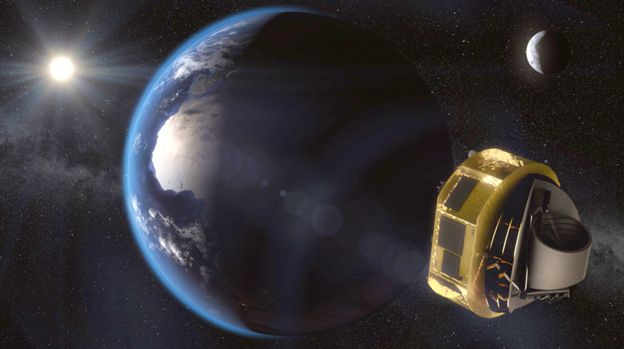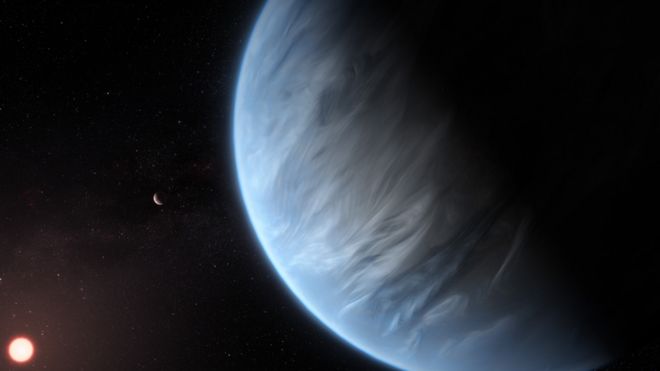Water Found for First Time on Potentially Habitable Planet

The
finding makes the world - which is called K2-18b - a plausible candidate in the
search for alien life.
Within
10 years, new space telescopes might be able to determine whether K2-18b's
atmosphere contains gases that could be produced by living organisms.
Details
were published in the scientific journal Nature Astronomy.
The
lead scientist, Prof Giovanna Tinetti of University College London (UCL)
described the discovery as "mind blowing".
"This
is the first time that we have detected water on a planet in the habitable zone
around a star where the temperature is potentially compatible with the presence
of life," she said.
The
habitable zone is the region around a star where temperatures are sufficiently
benign for water to exist in liquid form on the surface of a planet.
K2-18b
is 111 light-years - about 650 million million miles - from Earth, too far to
send a probe. So the only option is to wait for the next generation of space
telescopes to be launched in the 2020s and to look for gasses in the planet's
atmosphere that could only be produced by living organisms, according to UCL's
Dr Ingo Waldmann.
"This
is one of the biggest questions in science and we have always wondered if we
are alone in the Universe," Dr Waldmann said. "Within the next 10
years, we will know whether there are chemicals that are due to life in those
atmospheres."
The team behind the
discovery looked through the planets discovered by the Hubble Space Telescope
between 2016 and 2017. The researchers determined some of the chemicals in
their atmosphere by studying the changes to the starlight as the planets
orbited their suns. The light filtered through the planets' atmospheres was
subtly altered by the composition of the atmosphere.

Only K2-18b revealed
the molecular signature of water, which is a vital ingredient for life on
Earth. Computer modelling of the data suggested that up to 50% of its
atmosphere could be water.
The
new planet is just over twice the size of Earth and has a temperature cool
enough to have liquid water, between zero and 40C.
Dr
Angelos Tsiaras, a member of the UCL team, said that finding water in the
atmosphere of a potentially habitable exoplanet was "incredibly
exciting".
He
said: "It brings us closer to answering the fundamental question: Is the
Earth unique?"
One difficulty with
this approach, though, is that astronomers can't agree on which gases would
constitute evidence of life. That might be more of a longer haul.
It
is likely to require a survey of the chemical composition of, perhaps, hundreds
of worlds and an understanding of how they are created and evolve, according to
Prof Tinetti.
"The
Earth really stands out in our own Solar System. It has oxygen, water and
ozone. But if we find all that around a planet around a distant star we have to
be cautious about saying that it supports life," she said.
"This
is why we need to understand not just a handful of planets in the galaxy but
hundreds of them. And what we hope is that the habitable planets will stand
out, that we will see a big difference between the planets that are habitable
and the ones that are not."
Dr Beth Biller at
Edinburgh University's Institute of Astronomy said she believed that evidence
of life on a planet around a distant star would eventually be discovered.
"That
would be a paradigm shift for all of humanity," she told BBC News.
"It's
not going to be ET phoning home, necessarily - more likely microbes or some
other simple life. Even so (when it happens) it's going to be huge".
The
prospective launch of Nasa's much delayed James
Webb Space Telescope (JWST) in 2021, and the European Space Agency's Ariel
mission seven
years later, will enable astronomers to study in detail the atmospheres of the
varied worlds that have been detected so far.
Water
has been detected on other planets but they have been either too big or too hot
to support life. Cooler smaller planets are much harder to detect. The team at
UCL was able to do this by developing algorithms capable of teasing out the
chemical composition of the atmospheres of potentially habitable worlds
K2-18b
was discovered in 2015 and is one of hundreds of super-Earths - planets with a
mass between Earth and Neptune - found by Nasa's Kepler spacecraft. Nasa's Tess
mission is expected to detect hundreds more in coming years.
The
research was funded by the European Research Council and the UK Science and
Technology Facilities Council, which is part of the UK Research and Innovation
agency (UKRI).
FROM .bbc.com/news/science-environment

No comments